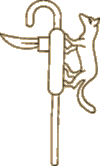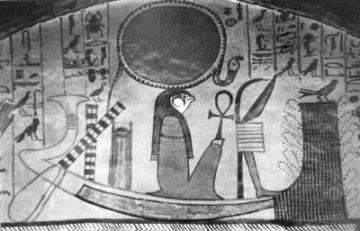
![]() The
object represented by this image is something of a mystery to Egyptologists even today. It seems to be a package lashed to a crook or staff, with a knife protruding from the package. The contents of the package are the subject of the two theories that try to identify the object, called the
shemes by the ancient Egyptians. The word shemes meant "to follow" or "to serve" and so it is possible that this object represented the equipment carried by the king's attendants. However, others belive that the shemes was more like the fasces, a bundle of rods and axes carried by lictors before Roman magistrates, in this case representing an instrument of execution.
The
object represented by this image is something of a mystery to Egyptologists even today. It seems to be a package lashed to a crook or staff, with a knife protruding from the package. The contents of the package are the subject of the two theories that try to identify the object, called the
shemes by the ancient Egyptians. The word shemes meant "to follow" or "to serve" and so it is possible that this object represented the equipment carried by the king's attendants. However, others belive that the shemes was more like the fasces, a bundle of rods and axes carried by lictors before Roman magistrates, in this case representing an instrument of execution.
The shemes sign appeared as far back as the early Dynastic period, and by the time that the Pyramid Texts were written, it had acquired a mortuary significance. The symbol was treated as a sort of demi-god, the Follower, apparently representing ancestral kings of the distant past. A papyrus of the Roman Period mentions "The Souls of Pe, Followers of Horus as Kings from Lower Egypt", and "The Souls of Nekhen, Followers of Horus as Kings from Upper Egypt". These would be the predynastic kings of Buto (Pe) and Hierakonopolis (Nekhen), who were united by the Upper Egyptian king Narmer. From the Old Kingdom onward, this symbol was used to represent a group of deities called the Followers of Horus.
 Another
deity associated with the Followers was the goddess Mafdet. In her
cat-like form, she was often depicted running up the side of one of these
Follower symbols. Mafdet was believed to protect the god Ra from serpents,
and it is perhaps this association that led, in later dynasties, to the
Followers appearing in the solar boat with Ra as he made his nightly journey
through the Underworld.
Another
deity associated with the Followers was the goddess Mafdet. In her
cat-like form, she was often depicted running up the side of one of these
Follower symbols. Mafdet was believed to protect the god Ra from serpents,
and it is perhaps this association that led, in later dynasties, to the
Followers appearing in the solar boat with Ra as he made his nightly journey
through the Underworld.
 It
is in New Kingdom depictions that
the Followers gain their greatest significance. They often accompany the
sun god in his boat as he travels through the night, in this case evidently
with a protective function. Egyptian artists often gave human characteristics
to symbols in certain contexts, and the Followers were no exception. Sometimes
the tail of rope that hung from the package was depictied as a leg, as
in this image from the Theban tomb of Sennedjem. Here the artist established
a visual pun on the literal meaning of the symbol, "to follow."
It
is in New Kingdom depictions that
the Followers gain their greatest significance. They often accompany the
sun god in his boat as he travels through the night, in this case evidently
with a protective function. Egyptian artists often gave human characteristics
to symbols in certain contexts, and the Followers were no exception. Sometimes
the tail of rope that hung from the package was depictied as a leg, as
in this image from the Theban tomb of Sennedjem. Here the artist established
a visual pun on the literal meaning of the symbol, "to follow."
The Followers could also be personified with the
addition of a head pendant from the tip of the staff. It is in this form
that they appear as funerary dieties in the book of Amduat, or "That
Which Is in the Underworld." As they appear in the Eighth Hour of
the Night on the walls of the tomb of King Seti I, the Followers are even
given names, and again serve in a protective function. They stand before
their funerary linens, ready to defeat the enemies of Ra.
